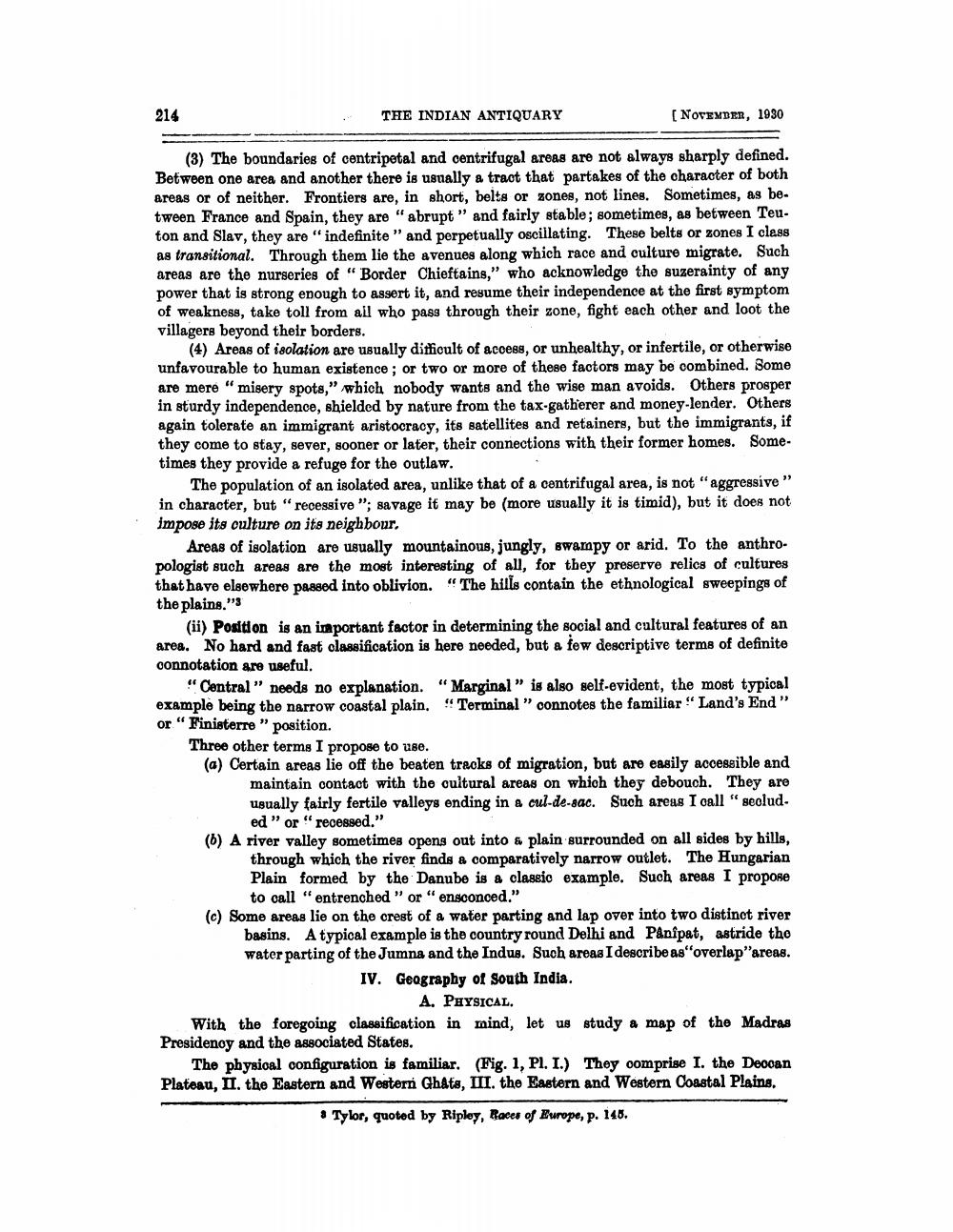________________
214
THE INDIAN ANTIQUARY
[NOVEMDEN, 1930
(3) The boundaries of centripetal and centrifugal areas are not always sharply defined. Between one area and another there is usually a tract that partakes of the character of both Areas or of neither. Frontiers are, in short, belts or zones, not lines. Sometimes, as between France and Spain, they are "abrupt” and fairly stable; sometimes, as between Teuton and Slav, they are "indefinite" and perpetually oscillating. These belts or zones I class as transitional. Through them lie the avenues along which race and culture migrate. Such areas are the nurseries of " Border Chieftains," who acknowledge the suzerainty of any power that is strong enough to assert it, and resume their independence at the first symptom of weakness, take toll from all who pass through their zone, fight each other and loot the villagers beyond their borders.
(4) Areas of isolation are usually difficult of acoesg, or unhealthy, or infertile, or otherwise unfavourable to human existence; or two or more of these factors may be combined. Some are mere “misery spots," which nobody wants and the wise man avoids. Others prosper in sturdy independence, shielded by nature from the tax-gatherer and money-lender. Others again tolerate an immigrant aristocracy, its satellites and retainers, but the immigrants, if they come to stay, sever, sooner or later, their connections with their former homes. Sometimes they provide a refuge for the outlaw.
The population of an isolated area, unlike that of a centrifugal area, is not "aggressive" in character, but "recessive"; savage it may be (more usually it is timid), but it does not impose its oulture on its neighbour,
Areas of isolation are usually mountainous, jungly, swampy or arid. To the anthropologist such areas are the most interesting of all, for they preserve relics of cultures that have elsewhere passed into oblivion. "The hills contain the ethnological sweepings of the plains."
(ii) Position is an important factor in determining the social and cultural features of an area. No hard and fast classification is here needed, but a few descriptive terms of definite connotation are useful.
"Central” needs no explanation. "Marginal" is also self-evident, the most typical example being the narrow coastal plain. "Terminal ” connotes the familiar" Land's End” or "Finisterre " position.
Three other terms I propose to use. (a) Certain areas lie off the beaten tracks of migration, but are easily accessible and
maintain contact with the cultural areas on which they debouch. They are usually fairly fertile valleys ending in a cul-de-sac. Such areas I call "seolud.
ed" or "recessed." (6) A river valley sometimes opens out into & plain surrounded on all sides by hills,
through which the river finds a comparatively narrow outlet. The Hungarian Plain formed by the Danube is a classic example. Such areas I propose
to call "entrenched" or "ensconced." (c) Some areas lie on the crest of a water parting and lap over into two distinct river
basins. A typical example is the country round Delhi and Panipat, astride the water parting of the Jumna and the Indus. Such areas I describe as overlap"areas.
IV. Geography of South India.
A. PHYSICAL. With the foregoing classification in mind, let us study a map of the Madras Presidenoy and the associated States
The physical configuration is familiar. (Fig. 1, PI. I.) They comprise I. the Deocan Plateau, II. the Eastern and Western Ghats, III. the Eastern and Western Coastal Plains,
Tylor, quoted by Ripley, Races of Europe, p. 148.




